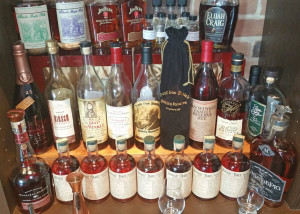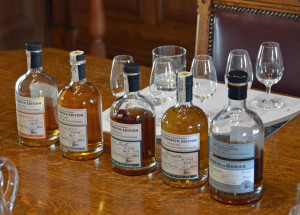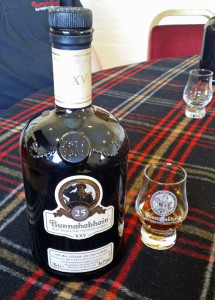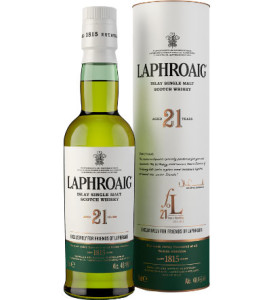Why Fine Single Malts Should Be Your Alternative To Pappy Van Winkle Fever
By Kurt Maitland
The annual outbreak of Pappy Fever has come and gone, and if you haven’t acquired a bottle of Pappy Van Winkle whiskey yet it will likely cost you dearly to do so. January is the time of the doldrums, of having come up empty handed, because that fever turns a well-loved/well-aged bourbon into something worth more than its weight in gold. Those websites and bloggers that devote so much time to tracking which states had received their release and auction sites poised to gouge those who couldn’t find it on their local liquor store shelves are now looking around, like a duck hit on the head, for something else to do.
Briefly, Pappy Van Winkle started at the now-legendary, currently half-shuttered Stitzel-Weller Distillery, and is now distilled and bottled by the Sazerac Company at its Buffalo Trace Distillery in Frankfort, Kentucky. Pappy Van Winkle’s Family Reserve has long been regarded as one of the finest bourbons in the world, but the modern Pappy Fever epidemic has turned its bottles from $70 dollar hidden gems into $2,000 luxury commodities.
Due to strict allocation, low production and high demand, it is rare to find bottles of Pappy displayed on shelves. Most liquor stores and bars in New York City don’t even get cases anymore, with allocation so tight in the Northeast that most establishments that can get some Pappy receive only a bottle or two, and are expected to make do until next year’s allocation. Even in Kentucky, America’s bourbon state, waiting lists are a thing of the past and consumers must rely on lotteries and camping out in front of liquor stores to guarantee a place at the front of the line, or else use insider connections to get a bottle of Pappy Van Winkle at the recommended list price.
Friends of mine from the UK and people who aren’t into whiskey generally don’t really understand what the big deal is. They don’t get why people pay what amounts to legal extortion for a bottle of bourbon. Walk into any good liquor store and other options (i.e. Elijah Craig 23 Year Old, Michter’s 20 Year Old, etc.) often present themselves if you are after very aged bourbon. Why won’t they do the trick?
At this point, Pappy is clearly more about the prestige of owning a bottle than the reality of drinking it. If that is the case, then a savvy whisk(e)y drinker who has the money and knows what to look for should make the move over to high end Scotch.
Why? It seems crazy to say when you are talking about dropping hundreds if not thousands on a single bottle of whisky, but as I will illustrate, you get more value for your money with an old Scotch, whether you opt to drink or collect it.
To make the comparison easier, these are my criteria: First, to focus on the 20 Year Old and the 23 Year Old Pappy releases only, as these are the ones that most people go crazy for; second, to compare Age, Bang for the Buck and Collectability between Pappy and Scotch.
Pappy vs. Scotch: Age
The oldest commercially released Pappy is the 23 Year Old. When I check Wine Searcher’s listing for a bottle, I see private sellers with prices ranging from $1,600 to almost $1,800. There are stores that list it for $1,900 a bottle and I’ve seen it go for two grand in New York. Keep in mind the MSRP is $249.99, but we know that most of you will not be able to acquire it at that price.
Yet you can get a 25 Year Old Glenfarclas (an amazing, family-owned Speyside distillery) for between $150 and $170 dollars. This single malt is cheaper than the list price on Pappy, and legions away from the price on the street. Hell, it’s priced at where you could maybe buy two, drink one on the spot and keep the other for a rainy day.
Sticking with Glenfarclas, and assuming that you had the funds to buy Pappy 23 Year Old at its current astronomical markup, did you know that you could buy a 46 Year Old independent bottling of Glenfarclas, from Douglas Laing’s Director’s Cut Series, for $1,250? Even when you ship it from Scotland, it would still be cheaper than the current mark up on the Pappy 23 Year Old, and if you want to puff your chest out you can rest assured, few, if any of your friends have 40 year old whisky sitting in their homes.
Pappy Vs. Scotch: Bang for the Buck
Pappy at its MSRP is a good buy, and I’d be deliriously happy to buy a bottle of the 20 Year Old for $149 or the 23 Year Old for $249, but for most of us realize that is never going to happen. But even using the MSRP price, and not the real market value, as a base, bargains can be had in the Scotch world for whiskies of a similar age. For example, Glendronach’s 21 Year Old Parliament Whisky, AnCnoc’s 22 Year Old Whisky, and Old Pulteney’s 21 Year Old Whisky, all well-priced single malts, can be found online for around $110 to $115, pre-shipping & handling. When you refer to the market price ($1,000 to $1,300) you can buy an entire case of any of these releases, with cash to spare.
Pappy vs. Scotch: Collectability
No one can say that Pappy isn’t collectable. That’s said, it is released every year. If you have the funds and the will to play in the collecting-for-profit leagues, there are a lot of rare single malt collectibles you could get for the market price of the hottest Pappy releases that should increase in value if only because they aren’t annually released, or better, come from a closed distillery. That should help keep the value up. Keep in mind that most of Pappy Van Winkle’s pre-fever cachet comes from just that point: being based on stock from the shuttered Stitzel-Weller Distillery.
Here are a few examples of single malts from 2014’s Special Releases from Diageo, all from defunct distilleries and available at your better liquor stores. Instead of a Pappy Van Winkle that probably hasn’t got a drop of Stitzel-Weller bourbon in it anymore, you could have gotten Rosebank 21 Year Old (a nice closed distillery) for $500. For $1,250 you could have gotten a 35 Year Old Brora, one of the most famous of the closed distilleries. This Brora gone up in value, it’s 15 years older, but is still going for less than the street price of the Pappy 20 Year Old. I’ve had it, and it’s a great whisky as well as a great starter to a collection. What is more, odds are you won’t lose money on Brora as an investment.
If you can think beyond bourbon, there are other options in the whisk(e)y world. If you can’t find Pappy at a price you can afford to pay, you now know of a few new options to work with. For those lucky enough to get Pappy or can afford to pay the steep mark-up to buy it at will, you too have a wider field to look at.
 The Whiskey Reviewer A World of Whiskey, Poured Every Weekday
The Whiskey Reviewer A World of Whiskey, Poured Every Weekday





Getting a hold of a real bourbon alternative to Pappy, like EC18 or Stagg, is almost as hard. Not as expensive, but almost as hard. As for Scotch, it’s a good point for people who like it. I’m not one of those.
Interesting story, makes me a little jealous of Scotch lovers. I wish I liked Scotch even a little. Comparing bourbon to Scotch is a little like comparing dogs and cats. Owners of either could be called ‘pet lovers” but rarely (though some do) enjoy both.
I like both, though I am definitely more of a single-malt scotch drinker. Scotch is very different from the Bourbon world in that flavor profiles vary wildly; the difference between a Laphroaig peat-monster and a Glendronach sherry-bomb is about as big as either of those compared to Bourbon. That said, there are some days when only Bourbon will do and, IMHO, the best old Stitzel-Weller stuff can go head to head with anything ever put in a bottle from Scotland.
Regarding the specific insanity with Pappy, it seems very similar to the situation with Macallan: marketing and hype. Investing in aged whisk(e)y (scotch or otherwise) especially at what looks like a market peak, seems like a bad idea. The market making for the Pappy’s and Macallan’s has been done, nobody is getting in at the ground floor with other brands because they are “other” brands.
Buy aged stuff to drink or hoard to drink later, but don’t buy it as an investment instrument. Throughout the ages, speculating on whiskey has proven disastrous.